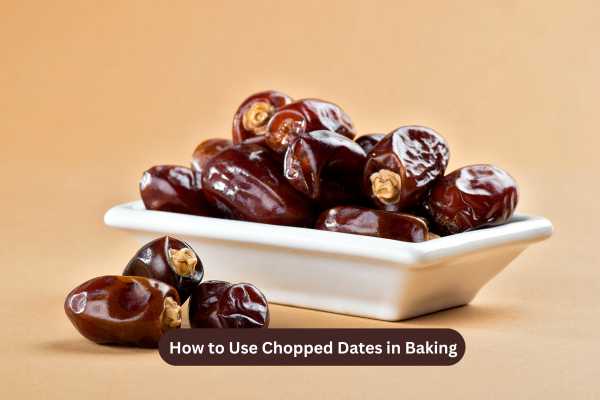Baking with chopped dates is one of the simplest ways to add natural sweetness, texture, and richness to your favourite homemade treats. Dates are a versatile ingredient often used in traditional British puddings, cakes, and biscuits, and they pair beautifully with nuts, chocolate, and spices. Whether you’re an experienced baker or just starting, learning how to use chopped dates in baking can elevate your recipes to a new level of flavour and nutrition.

Why Use Chopped Dates in Baking?
Dates are naturally sweet, which makes them an excellent substitute for refined sugar. They are packed with essential nutrients such as fibre, potassium, and antioxidants, offering a healthier way to sweeten your bakes without compromising on taste. When chopped and added to batters or doughs, dates provide bursts of caramel-like flavour and a soft, chewy texture that complements both sweet and savoury bakes.
In addition, chopped dates help retain moisture in baked goods. This means your cakes, muffins, and loaves stay fresher for longer, with a pleasant, tender crumb. Their natural sugars also contribute to a rich golden-brown colour, enhancing the visual appeal of your finished treats.
Choosing the Right Type of Dates
Before you start baking, it’s important to choose the right variety of dates. The most common types available in UK supermarkets are Medjool, Deglet Noor, and Sayer dates.
-
Medjool Dates: Known for their soft texture and intense sweetness, Medjool dates are ideal for cakes, brownies, and sticky puddings.
-
Deglet Noor Dates: These are slightly firmer and less sweet, perfect for biscuits, scones, or recipes where you want a subtle flavour.
-
Sayer Dates: Often used in baking mixes or chopped form, these dates are affordable and easy to work with.
Whichever variety you choose, always check for stones before chopping, even if the packet says “pitted.” A missed stone can easily damage a food processor blade or ruin the texture of your bake.
How to Chop Dates for Baking
Dates can be sticky, making them tricky to chop evenly. Here are a few simple tips:
-
Use a sharp knife: A clean, sharp blade ensures neat cuts.
-
Lightly dust with flour: Toss the dates in a small amount of flour before chopping to prevent clumping.
-
Use kitchen scissors: Snipping dates with scissors can be faster and less messy than using a knife.
-
Avoid over-chopping: Keep the pieces small but chunky enough to provide texture.
Once chopped, you can toss them with a little extra flour before adding to your batter or dough. This helps distribute them evenly and prevents them from sinking to the bottom during baking.
Soaking Chopped Dates – When and Why
In some recipes, particularly for cakes and puddings, soaking chopped dates can enhance both flavour and texture. Soaking softens the fruit and releases natural sugars, which blend beautifully into your mixture.
To soak, simply cover the chopped dates with warm water, milk, or even a splash of brewed tea for added depth. Let them sit for about 10–15 minutes before draining and adding to your recipe. For a richer result, some bakers soak dates in orange juice, rum, or brandy to complement festive or fruit-based cakes.
Best Bakes to Make with Chopped Dates
Chopped dates can be used in nearly any baked good that benefits from sweetness and moisture. Here are some popular ideas:
1. Date and Walnut Loaf
A classic British favourite, this moist loaf combines the sweetness of dates with the crunch of walnuts. It’s perfect for afternoon tea and pairs beautifully with butter.
2. Sticky Toffee Pudding
One of the most beloved desserts in the UK, sticky toffee pudding relies on chopped dates for its signature texture and rich caramel flavour. Soaked dates form the base of the sponge, giving it a melt-in-the-mouth consistency.
3. Date Cookies or Biscuits
Add chopped dates to your cookie dough for a chewy, naturally sweet twist. They work especially well with oats, coconut, or dark chocolate chips.
4. Muffins and Cupcakes
Dates blend seamlessly into muffin batters, adding sweetness without overwhelming the other flavours. Combine with spices like cinnamon or ginger for a warming, wholesome treat.
5. Energy Bars and Flapjacks
Chopped dates act as a natural binder in homemade flapjacks and energy bars. They hold oats and nuts together while providing natural sugar and fibre.
Tips for Baking with Chopped Dates
-
Adjust sweetness: If using dates, reduce the added sugar slightly to avoid an overly sweet result.
-
Combine with spices: Dates pair beautifully with cinnamon, nutmeg, and cardamom for an aromatic finish.
-
Store properly: Keep chopped dates in an airtight container in a cool, dry place. If you won’t use them for a while, refrigerate or freeze them.
-
Experiment with blends: Combine dates with raisins, cranberries, or apricots for more complex flavours in fruitcakes or buns.
Health Benefits of Baking with Dates
Aside from their delicious taste, dates provide a range of health benefits. They are high in dietary fibre, which supports digestion, and contain potassium and magnesium, which contribute to heart and muscle health. Unlike refined sugar, dates offer slow-release energy, helping to keep you full and energised for longer.
By replacing part of the sugar in your recipes with chopped dates, you can enjoy a more nutritious bake without losing the indulgent flavour that makes homemade treats so satisfying.
Final Thoughts
Using chopped dates in baking is an easy way to bring natural sweetness, texture, and depth of flavour to your favourite recipes. From classic sticky toffee pudding to wholesome breakfast muffins, this simple ingredient can transform your bakes into something truly special. Whether you choose to soak them, mix them into dough, or sprinkle them into batters, chopped dates deserve a permanent place in your baking cupboard.

